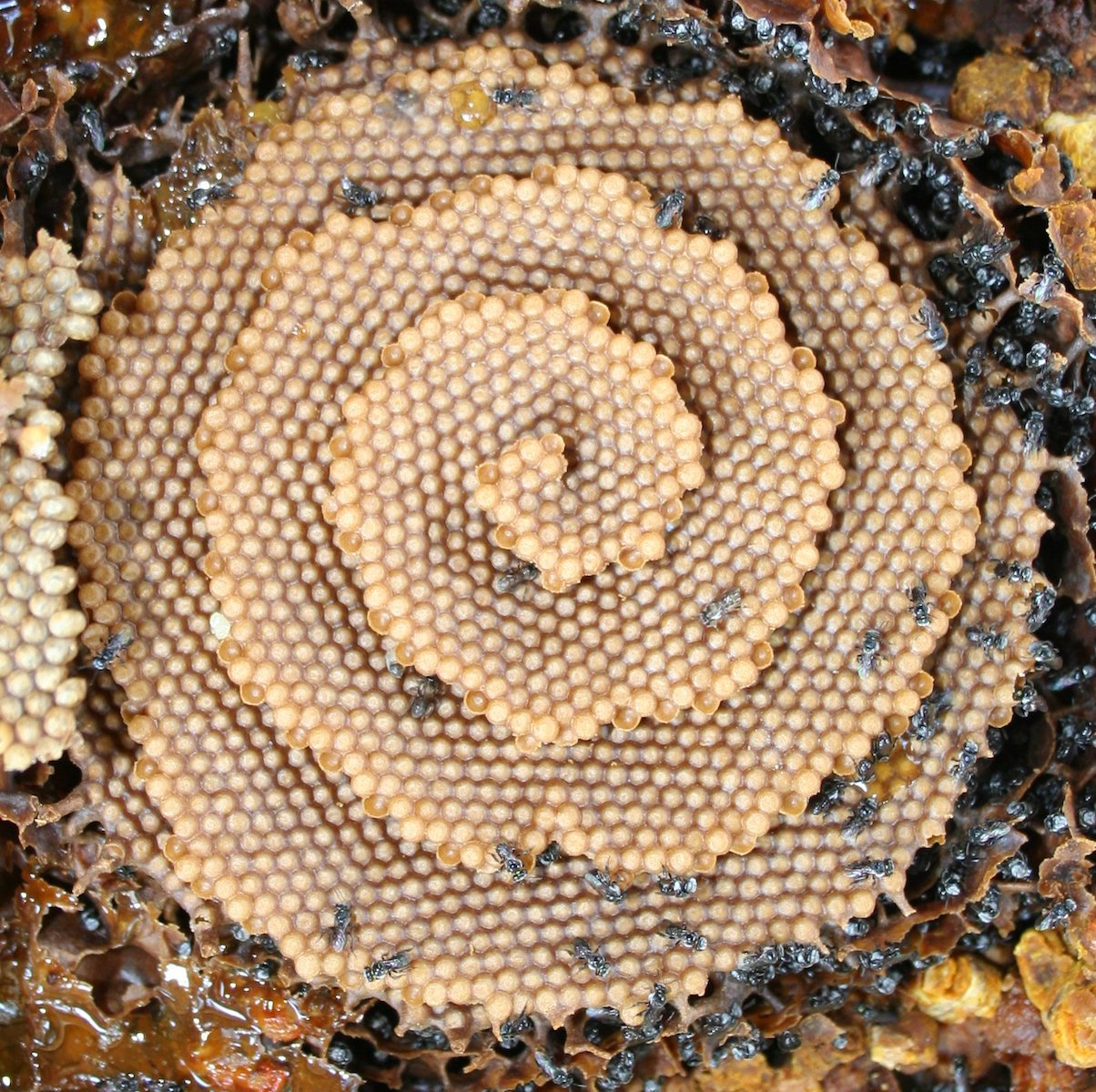Nobody Knows Why These Bees Built a Spiral Nest

The Australian stingless bee Tetragonula carbonaria is not your average pollinator. For starters, out of about 20,000 known bee species in the world, T. carbonaria is one of only 500 without stingers.
That's not to say this bee is defenseless. Invasive beetles that have tried to infiltrate T. carbonaria nests have found themselves suddenly covered in a brew of wax, mud and plant resin — effectively mummified alive by bees. T. carbonaria colonies have also been observed waging days-long territory wars against their stingless neighbors, resulting in hundreds of bee-on-bee casualties and queens unceremoniously dethroned.
This is all to say, if you had a home like T. carbonaria's, you'd probably fight for it, too. As seen in a popular photo posted to Reddit last week, swarms of T. carbonaria rear their young in mesmerizing, spiral-shaped towers called brood combs, linking hundreds of individual egg chambers together into a continuous staircase of unborn baby bees. [Here's What Wasp Faces Look Like Up-Close]
"The image is just one layer of the brood comb," entomologist Tim Heard, who took the photo while researching stingless bees for The Commonwealth Scientific and Industrial Research Organisation (CSIRO) in Australia, said in an email."A fully developed nest consists of 10-20 layers. Each layer is one circle of a continuous spiral."
The little circular pods you see forming this spiral are called brood cells. Within these cells, individual bees grow from egg to adulthood in the span of about 50 days, Heard wrote in his stingless bee-keeping manual, "The Australian Native Bee Book" (Sugarbag Bees, 2015). To build these cells, worker bees secrete wax from their abdominal glands and mix it with a plant resin derivative, making a sturdy construction material called cerumen.
"A cell is [then] mass provisioned by nurse workers regurgitating food to about two-thirds of the capacity of the cell, which is sufficient to feed the larva for its entire development to a pupa," Heard wrote. "The queen lays an egg on the provisions. The cell is then immediately capped so that the larva can develop in a closed cell."
When one cell is completed, workers move onto another, building new cells outward and upward in a spiral pattern, Heard wrote. Eventually, adult bees start emerging from the oldest cells built in the center of the lowest level of the brood comb, leaving behind a steadily growing cavity of empty husks known as the retreating edge. (You can identify the newly hatched bees in the photo by their silvery sheen — their skin will darken to its mature color a few days after the bees leave their cells.)
Get the world’s most fascinating discoveries delivered straight to your inbox.
As this cavity of empty cells grows from the bottom up, workers begin building a brand new brood inside it, continuing the cycle. A single colony could potentially live indefinitely in this fashion, Heard and his colleagues theorized, so long as it had a queen to lay new eggs.
So, why the spiral shape? Researchers have tried (and sort of failed) to explain the bee's construction guidelines as an algorithm that every worker bee innately knows. But Heard, for one, would as soon leave it to mystery.
"It may be unwise to attempt to explain the adaptive significance of why this form may have evolved," Heard told Live Science. "Perhaps, it is just the outcome of some random behavior or perhaps it is adaptive. A possible adaptive advantage of this form is that it is efficient use of space and also facilitates the circulation of air between the layers. But then one has to ask, why it is not more common."
Originally published on Live Science.

Brandon is the space / physics editor at Live Science. With more than 20 years of editorial experience, his writing has appeared in The Washington Post, Reader's Digest, CBS.com, the Richard Dawkins Foundation website and other outlets. He holds a bachelor's degree in creative writing from the University of Arizona, with minors in journalism and media arts. His interests include black holes, asteroids and comets, and the search for extraterrestrial life.
 Live Science Plus
Live Science Plus






